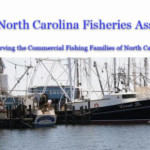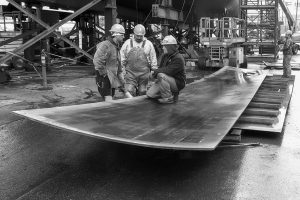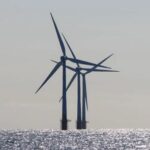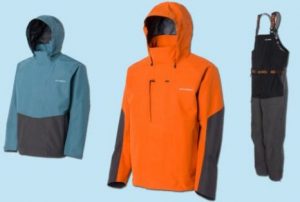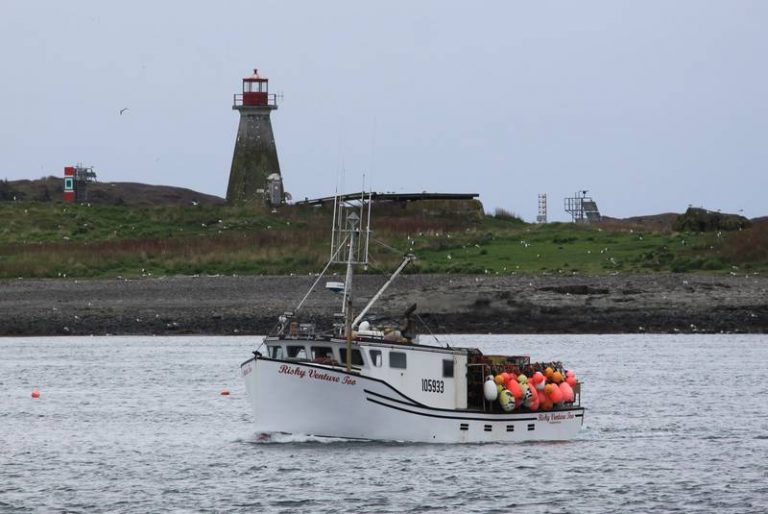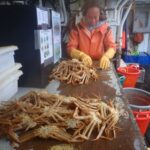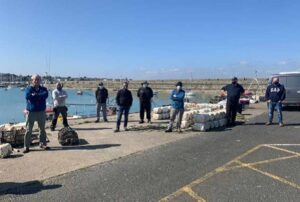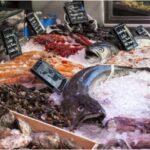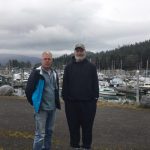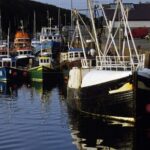Daily Archives: August 30, 2016
Deadliest Catch Captains Making Mischief for charity at The Captain’s Whiskey Slam
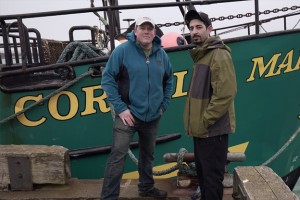 In what may very well be the most chest-hair-growing partnership in modern memory, Fremont Mischief Distillery has teamed up with Deadliest Catch celebrity crab captains Sig Hansen and Casey McManus, as well as co-captain Josh Harris, to make whiskey for charity at The Captain’s Whiskey Slam. Fremont Mischief’s new rye whiskey, Storm Tossed Rye, is a special batch that has been barrel-aged aboard Sig Hansen’s Northwestern and Casey McManus’ and Josh Harris’ Cornelia Marie. The whiskey batch, aged on the two different boats, is going head-to-head in true Deadliest Catch competition style. The goal is to sell all of the Storm Tossed Ryewhiskey between the release date, August 20, and October 1 in order to donate $40,000 to Seattle’s Fisherman Memorial and Sea Scouts’ Propeller and Yankee Clipper educational vessel efforts. The vision for the event comes from Doug Dixon, manager of Pacific Fishermen Shipyard, and Mike Sherlock, owner of Fremont Mischief Distillery and 29-year veteran of commercial fishing. Read the story here 20:34
In what may very well be the most chest-hair-growing partnership in modern memory, Fremont Mischief Distillery has teamed up with Deadliest Catch celebrity crab captains Sig Hansen and Casey McManus, as well as co-captain Josh Harris, to make whiskey for charity at The Captain’s Whiskey Slam. Fremont Mischief’s new rye whiskey, Storm Tossed Rye, is a special batch that has been barrel-aged aboard Sig Hansen’s Northwestern and Casey McManus’ and Josh Harris’ Cornelia Marie. The whiskey batch, aged on the two different boats, is going head-to-head in true Deadliest Catch competition style. The goal is to sell all of the Storm Tossed Ryewhiskey between the release date, August 20, and October 1 in order to donate $40,000 to Seattle’s Fisherman Memorial and Sea Scouts’ Propeller and Yankee Clipper educational vessel efforts. The vision for the event comes from Doug Dixon, manager of Pacific Fishermen Shipyard, and Mike Sherlock, owner of Fremont Mischief Distillery and 29-year veteran of commercial fishing. Read the story here 20:34
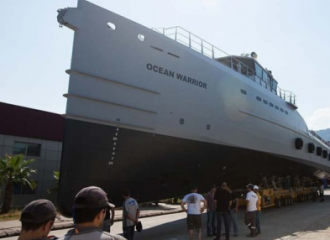
Sea Shepherd launches new ship that can ‘outrun’ Japanese whalers
“For the first time we will have the speed to catch and outrun the Japanese harpoon ships, knowing speed can be the deciding factor when saving the lives of whales in the Southern Ocean,” Alex Cornelissen, Sea Shepherd Global CEO, said in a statement. The new ship — dubbed “Ocean Warrior” — is 54 meters (177 feet) long, displaces 439 tons and can reach speeds of 25 knots and higher. Japanese whaling ships are estimated to reach speeds of up to 22 knots, and Sea Shepherd’s previous ships could only reach 15 knots. A deck area also enables ship operators to dispatch small boat operations and support a helicopter. The ship was built in Turkey by Dutch shipbuilder Damen from an 8.3 million euro ($9 million) fund awarded to Sea Shepherd by the Dutch, UK and Swedish lotteries. Video, Read the rest here 19:34
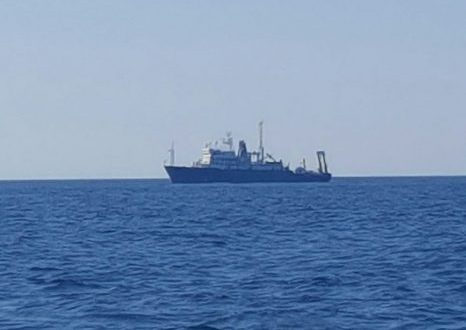
We were here first
So this is what the future looks like in late August from the deck of a fishing vessel south of the Vineyard. This ship is doing a survey looking for good bottom in which to plant offshore wind turbines. Fishermen are looking at this in the same way the Plains Indians probably looked at the Iron Horse. They may not have been up on the marvels of technology but I believe when they heard that whistle blowing they had a gut feeling that there were going to be winners and losers in the new order and they had no illusions about which end of the deal they would probably be getting. This particular area of the ocean is important to squid fishermen and if the turbines go in the fishermen will no longer be able to fish there. These remaining groundfish boats have already been squeezed out of other fisheries given the small quota they are allowed to catch and this represents another threat to their livelihood and way of life.
Promote greater scientific and socio-economic understanding of our nation’s fisheries and our fishing industry
Support the Center for Sustainable Fisheries www.centerforsustainablefisheries.org
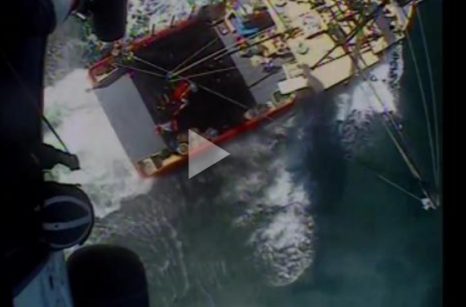
Updated: Video available – Coast Guard medevacs wounded lobsterman
A Coast Guard helicopter crew from Air Station Cape Cod medically evacuated an injured 41-year-old lobsterman Tuesday 130 nautical miles east of Cape Cod. At about 10:15 a.m., a crewmember aboard the lobster boat Eagle contacted watchstanders at the First Coast Guard District command center requesting assistance for a crewmember who had accidentally been impaled. A Coast Guard flight surgeon recommended a medevac and Air Station Cape Cod launched an MH-60 Jayhawk helicopter at about 11 a.m. The air crew arrived on scene, hoisted the man, and is currently in transit to Cape Cod Hospital. More details when available. 14:51 Watch the video here
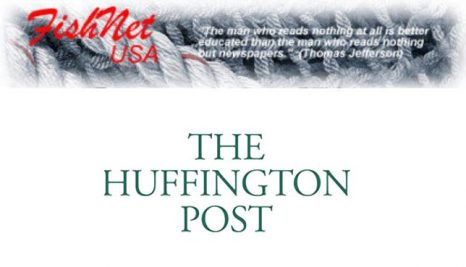
When it comes to fish and fishing Huffington Post is all wet – Nils E. Stolpe/FishNet USA
Last week Dana Ellis Hunnes, a Huffington Post blogger, managed to package in just 700 words more false, misleading, distorted and just plain wrong information about fish and seafood production than I’ve ever seen in works with far more words by professional anti-fishing activists. Addressing her inaccuracies on a point by point basis: Sustainable Fish Do Not Exist – Starting out with her title, the Merriam-Webster definition of sustainable is “able to be used without being completely used up or destroyed, involving methods that do not completely use up or destroy natural resources, able to last or continue for a long time.” The concept of renewable resources revolves around the sustainable utilization of those resources. Click here to read the full article 13:27
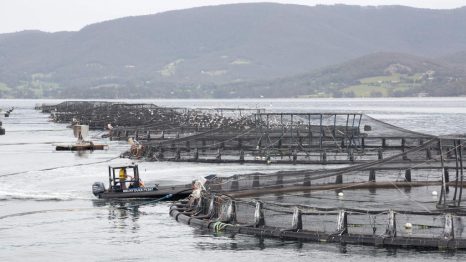
Meanwhile, in Tasmania – Drag fish farm regulation into 21st century
Sea based fish farms dump tonnes of faeces into the water. Think of them as a large toilet that does not flush. I cannot think of an industry in Tasmania other than aquaculture that is allowed to dump an unlimited amount of pollution in our waterways. Not only is there no limit on the amount of faeces salmon farms can dump in coastal waters, Tasmania also lacks science-based regulations to determine which parts of our coastline are suitable for salmon farms. International research shows that if you put fish farms in bays and harbours, where the water is shallow and current speed is low, fish faeces accumulates under cages, killing everything below them. Nitrogen discharged into the water column creates risk of harmful algal blooms, like the types we have seen worsening with increased salmon farms in the Huon and D’Entrecasteaux Channel. Other countries have responded to this research by offering incentives to move farming onshore. Read the story here 12:46
Controversial fish farm footage released
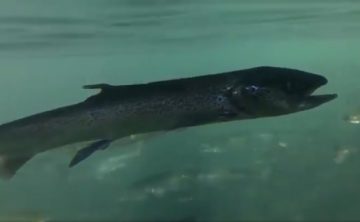 A B.C. environmentalist claims she has shocking new evidence that B.C. fish farms are carrying diseases that could potentially infect wild salmon. Earlier this summer, biologist Alexandra Morton and members of local First Nations visited a salmon farm in the Broughton Archipelago on B.C.’s central coast. “I had 10 minutes to stick my camera under the water and look at these fish and this is what I saw,” Morton said. “I was stunned. I saw a fish go by with a big tumour on his head.” Then she saw a salmon that was so emaciated that it hardly looked like a salmon at all. Video, read the story here 12:19
A B.C. environmentalist claims she has shocking new evidence that B.C. fish farms are carrying diseases that could potentially infect wild salmon. Earlier this summer, biologist Alexandra Morton and members of local First Nations visited a salmon farm in the Broughton Archipelago on B.C.’s central coast. “I had 10 minutes to stick my camera under the water and look at these fish and this is what I saw,” Morton said. “I was stunned. I saw a fish go by with a big tumour on his head.” Then she saw a salmon that was so emaciated that it hardly looked like a salmon at all. Video, read the story here 12:19
DFO seized, returned 1,350 pounds of lobster into the Annapolis Basin
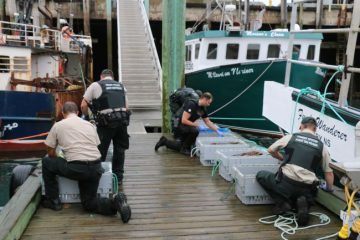 A half dozen officers with the Department of Fisheries and Oceans Canada took a dozen crates of lobster onto a floating dock at the Digby wharf Aug. 26, took the bands off the lobster and put the crustaceans back in the water. Fishery officer Jacklyn Titus said officers seized the 1,350 pounds of lobster earlier on Aug. 26 after an investigation on board a fishing vessel in Margaretville involved with the Aboriginal Food Fishery. Six people were arrested as a result of that investigation. All were later released. Titus says charges are pending. Click here for more photo 12:00
A half dozen officers with the Department of Fisheries and Oceans Canada took a dozen crates of lobster onto a floating dock at the Digby wharf Aug. 26, took the bands off the lobster and put the crustaceans back in the water. Fishery officer Jacklyn Titus said officers seized the 1,350 pounds of lobster earlier on Aug. 26 after an investigation on board a fishing vessel in Margaretville involved with the Aboriginal Food Fishery. Six people were arrested as a result of that investigation. All were later released. Titus says charges are pending. Click here for more photo 12:00
UMaine scientist – population size of scallops affects fertilization success
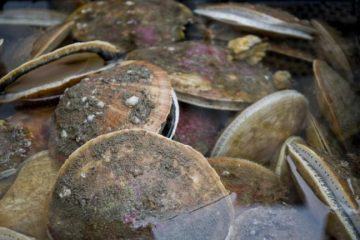 Scallop gonads may seem like fun and games to Skylar Bayer given that her missing samples landed her on “The Colbert Report” in 2013. But scallops are no laughing matter to Bayer. “When I was deciding on a Ph.D. project to pursue, I chose to work on a species that is commercially important and relevant to people’s daily life,” says Bayer, who is based at the University of Maine Darling Marine Center in Walpole. “Giant sea scallops in Maine seemed extraordinarily relevant.” In 2015, Maine fishermen brought in 452,672 pounds of scallop meat valued at $12.70 per pound — the highest in years. But scallops haven’t always done well in Maine and beyond. In the 1990s, after huge reductions in multiple fishery landings, including giant sea scallops, NOAA regulators instituted large fishing closures to try to bolster groundfish stocks. After four years, scallop stocks had increased 14 times what they were prior to the closure. Seeking a similar success story, Maine followed suit in 2009 and instituted a three-year scallop fishing closure. Read the story here 10:38
Scallop gonads may seem like fun and games to Skylar Bayer given that her missing samples landed her on “The Colbert Report” in 2013. But scallops are no laughing matter to Bayer. “When I was deciding on a Ph.D. project to pursue, I chose to work on a species that is commercially important and relevant to people’s daily life,” says Bayer, who is based at the University of Maine Darling Marine Center in Walpole. “Giant sea scallops in Maine seemed extraordinarily relevant.” In 2015, Maine fishermen brought in 452,672 pounds of scallop meat valued at $12.70 per pound — the highest in years. But scallops haven’t always done well in Maine and beyond. In the 1990s, after huge reductions in multiple fishery landings, including giant sea scallops, NOAA regulators instituted large fishing closures to try to bolster groundfish stocks. After four years, scallop stocks had increased 14 times what they were prior to the closure. Seeking a similar success story, Maine followed suit in 2009 and instituted a three-year scallop fishing closure. Read the story here 10:38
Gov. Scott Walker Confident New Lake Superior Fishing Agreement Will Be Reached
 Gov. Scott Walker got a closer look at state and commercial fisheries Monday when his tour of northern Wisconsin made a stop at Lake Superior’s Apostle Islands. During the visit, Walker acknowledged recent discussions to reach a new fishing agreement between the state Department of Natural Resources and local tribes, after a 10-year-old contract expired last year. Fishing in the lake is jointly managed by the state, the Bad River Band of Lake Superior Tribe of Chippewa Indians and the Red Cliff Band of Lake Superior Chippewa. Some sport and commercial fishermen are frustrated by state rules that don’t apply to tribes. The chairman of the Great Lakes Indian Fish and Wildlife Commission has said any suggestion that tribes are depleting the resource is 100 percent false. Read the story here 09:40
Gov. Scott Walker got a closer look at state and commercial fisheries Monday when his tour of northern Wisconsin made a stop at Lake Superior’s Apostle Islands. During the visit, Walker acknowledged recent discussions to reach a new fishing agreement between the state Department of Natural Resources and local tribes, after a 10-year-old contract expired last year. Fishing in the lake is jointly managed by the state, the Bad River Band of Lake Superior Tribe of Chippewa Indians and the Red Cliff Band of Lake Superior Chippewa. Some sport and commercial fishermen are frustrated by state rules that don’t apply to tribes. The chairman of the Great Lakes Indian Fish and Wildlife Commission has said any suggestion that tribes are depleting the resource is 100 percent false. Read the story here 09:40
Twitter users upset with the Cuomo brothers, saying the two fished a threatened species and should be ashamed of their actions.
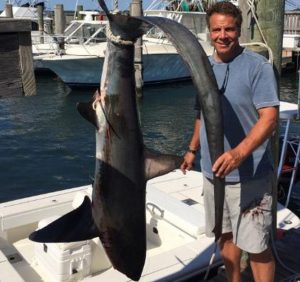 New York Governor Andrew Cuomo faced quite a bit of Twitter backlash after posing with the more than 150-pound thresher shark he caught off the coast of Long Island. His brother, CNN anchor Chris Cuomo, posted a photo of the fishing group on Instagram. National Oceanic and Atmospheric Administration determined threshers arenot at risk of extinction. But that didn’t seem to curb public opinion. In response to the controversy, a representative for Governor Cuomo told the New York Post, “This is an edible game fish that is indigenous to New York waters, and catching them is allowable under both state and federal regulations.” In 2013, Governor Cuomo was heralded for his decision to ban the possession and sale of shark fins — a popular delicacy in New York’s Chinatown. Read the rest here 08:43
New York Governor Andrew Cuomo faced quite a bit of Twitter backlash after posing with the more than 150-pound thresher shark he caught off the coast of Long Island. His brother, CNN anchor Chris Cuomo, posted a photo of the fishing group on Instagram. National Oceanic and Atmospheric Administration determined threshers arenot at risk of extinction. But that didn’t seem to curb public opinion. In response to the controversy, a representative for Governor Cuomo told the New York Post, “This is an edible game fish that is indigenous to New York waters, and catching them is allowable under both state and federal regulations.” In 2013, Governor Cuomo was heralded for his decision to ban the possession and sale of shark fins — a popular delicacy in New York’s Chinatown. Read the rest here 08:43
More fishermen have lost their lives in 2016 than in whole of 2015
 Simon Potten, Head of Safety, Training and Services reacts to the publication of the MAIB’s Annual Report and the steps Seafish are taking to tackle its tragic findings. The publication of the Marine Accident Investigation Branch’s (MAIB) Annual Report for 2015 provides an opportunity for the fishing industry and all those actively trying to improve fishing safety to take stock of how well we are doing, he said. The two most reliable indicators of fishing safety are the number of fishing vessels lost and, tragically, the number of fishermen lost. In 2015, 13 fishing vessels were lost, representing 0.23% of the fleet. What is more saddening is that more fishermen have lost lives in 2016 already, than in the whole of 2015, which we revealed last month. This is unacceptable and it is vital that the industry as a whole do more to improve the safety record of the fishing industry. Read the story here 07:41
Simon Potten, Head of Safety, Training and Services reacts to the publication of the MAIB’s Annual Report and the steps Seafish are taking to tackle its tragic findings. The publication of the Marine Accident Investigation Branch’s (MAIB) Annual Report for 2015 provides an opportunity for the fishing industry and all those actively trying to improve fishing safety to take stock of how well we are doing, he said. The two most reliable indicators of fishing safety are the number of fishing vessels lost and, tragically, the number of fishermen lost. In 2015, 13 fishing vessels were lost, representing 0.23% of the fleet. What is more saddening is that more fishermen have lost lives in 2016 already, than in the whole of 2015, which we revealed last month. This is unacceptable and it is vital that the industry as a whole do more to improve the safety record of the fishing industry. Read the story here 07:41


































